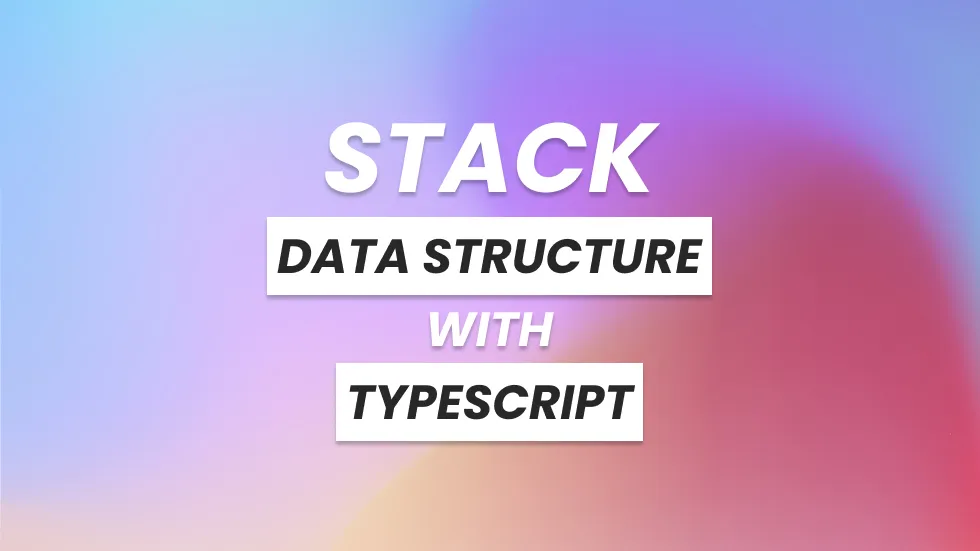
Data structures with TypeScript - Stack
This is the first of a multi-part series where we will be implementing some popular data structures using TypeScript. This week’s focus is Stack data structure.
What is a Stack?
A stack is a linear data structure that follows the order of Last In First Out(LIFO). This means the first inserted element will be removed last. You can think of the stack as a pile of books that are placed on top of one another.

Use cases of Stack data structure.
The stack can be useful in a situation where the order of the data inserted is important. Following are some common scenarios where stack can be useful.
- Javascript call stack - Keep track of function calls
- Undo/Redo - Undo by removing the last element in the stack, and redo by inserting the last removed item from the stack
- Reversing - Reverse a string
Basic operations of a Stack
A stack should be able to perform the following basic operations.
- Push: Add an element to the top of a stack
- Pop: Remove an element from the top of a stack
- IsEmpty: Check if the stack is empty
- IsFull: Check if the stack is full
- Peek: Get the value of the top element without removing it

Implementation
In order to implement the Stack data structure, we can follow the following steps.
- Define a variable called
TOPto keep track of the first element in the stack - When initialized, set the value of
TOPto-1. Later we can use this to check if the stack is empty or not. - Whenever an item is pushed, increase the value of
**TOP**by 1 and place the new element at the position pointed byTOP. Also, check if the stack is full before pushing a new element. - Whenever an item is popped, decrease the value of
TOPby 1. Also, check if the stack is empty before popping an element.
Following is the TyepeScript implementation of the Stack data structure
class Stack<T> {
private _top: number
private _capacity: number
private _stack: T[]
constructor(capacity: number) {
this._top = -1
this._capacity = capacity
this._stack = [] as T[]
}
get stack() {
return this._stack
}
isEmpty(): boolean {
return this._top === -1
}
isFull(): boolean {
return this._top === this._capacity - 1
}
peek(): T {
return this._stack[0]
}
push(item: T) {
if (this.isFull()) {
console.log('Failed: Maximum capacity reached')
return false
}
this._stack.push(item)
this._top++
}
pop() {
if (this.isEmpty()) {
console.log('Failed: Stack is already empty')
return false
}
this._stack.pop()
this._top--
}
printStack() {
this._stack.forEach((item, index) => {
console.log(`Item at index ${index} => ${item}`)
})
}
}Testing
Now that we have implemented the Stack data structure using TypeScript, it is time to test the functionalities of our Stack. We will be using Jest to write some important test cases.
describe('test stack functionality', () => {
it('should be empty when initialized', () => {
const stack = new Stack(10)
const isEmpty = stack.isEmpty()
expect(isEmpty).toBe(true)
})
it('should be full when max capacity is reached', () => {
const stack = new Stack<string>(2)
stack.push('🐅')
stack.push('🐐')
const isFull = stack.isFull()
expect(isFull).toBe(true)
})
it('should add items to the stack', () => {
const stack = new Stack<number>(3)
stack.push(2)
stack.push(3)
expect(stack.stack).toStrictEqual([2, 3])
})
it('should remove items from the stack', () => {
const stack = new Stack<string>(5)
stack.push('a')
stack.push('b')
stack.push('c')
stack.push('d')
stack.push('e')
stack.pop()
stack.pop()
expect(stack.stack).toStrictEqual(['a', 'b', 'c'])
})
it('should not allow adding more item than the capacity', () => {
const stack = new Stack<number>(1)
stack.push(2)
const status = stack.push(3)
expect(status).toBe(false)
})
it('should not allow removing item when the stack is empty', () => {
const stack = new Stack<number>(1)
const status = stack.pop()
expect(status).toBe(false)
})
it('should return the first element', () => {
const stack = new Stack<string>(3)
stack.push('hello')
stack.push('world')
stack.push('people')
const firstElement = stack.peek()
expect(firstElement).toBe('hello')
})
})